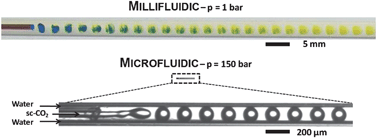Some recent advances in the design and the use of miniaturized droplet-based continuous process: Applications in chemistry and high-pressure microflows†
Abstract
This mini-review focuses on two different miniaturizing approaches: the first one describes the generation and use of droplets flowing within a millifluidic tool as individual batch microreactors. The second one reports the use of high pressure microflows in chemistry. Millifluidics is an inexpensive, versatile and easy to use approach which is upscaled from microfluidics. It enables one to produce hierarchically organized multiple emulsions or particles with a good control over sizes and shapes, as well as to provide a convenient data acquisition platform dedicated to slow or rather fast chemical reactions, i.e., from hours to a few minutes. High-pressure resistant devices were recently fabricated and used to generate stable droplets from pressurized fluids such as supercritical fluid–liquid systems. We believe that supercritical microfluidics is a promising tool to develop sustainable processes in chemistry.

- This article is part of the themed collection: 10th Anniversary Issue: France

 Please wait while we load your content...
Please wait while we load your content...